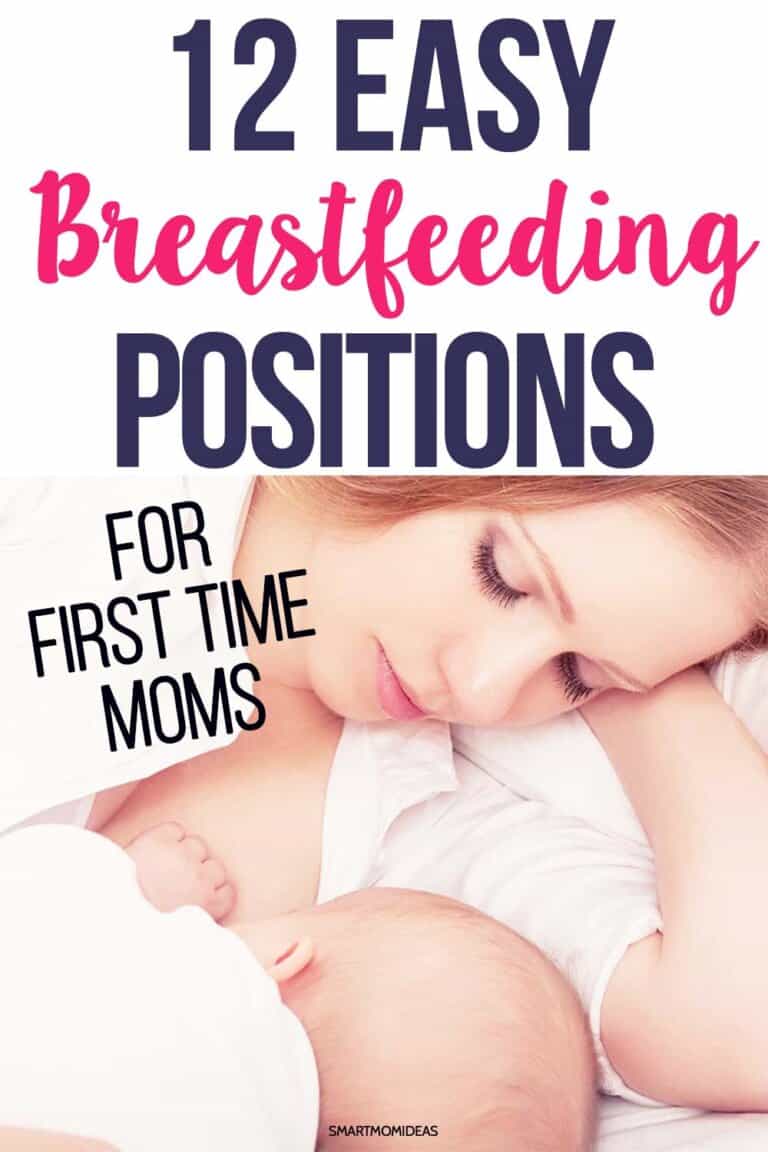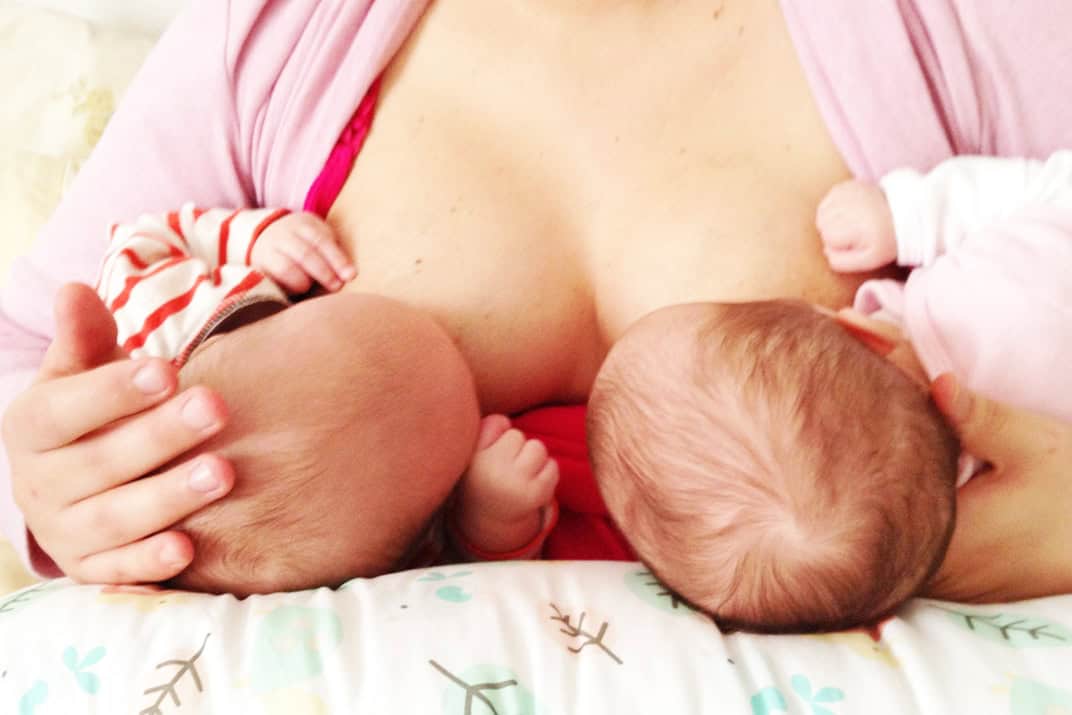Get the lowdown on breastfeeding positions for new moms!

Our breasts naturally create milk for our little ones – so shouldn’t feeding them come naturally too?
One of my fondest moments of early motherhood was breastfeeding – except I had to juggle twins! Let me tell you, there is no “one-size-fits-all” perfection position to hold your baby (or babies!) while nursing them.
Unfortunately, this is sometimes not the case for moms who have trouble positioning themselves and their little one comfortably to promote a good latch and increase milk supply.
However, there are some tried-and-true holds you can experiment with to meet your baby’s unique needs.
Every mom and child is different but these twelve breastfeeding positions will give you lots of choices when it comes to making it easier to nurse your little one.
1. Reclined Position

If you place your baby on your chest as soon as they are born, more than likely they’ll instinctively work their way toward your breast and attempt to latch on!
This natural position is known as the reclined position and is perfect for newborns and babies as well.
Recline gently in a chair or against some comfy pillows and allow your little one to latch while lying with their stomach against yours.
This position is useful if your baby is struggling to latch, if you have a forceful let-down or if your breasts are large.
For Breastfeeding Help Check out Milkology’s Breastfeeding Class

2. Dancer Hand Position
For babies who struggle to stay latched, or have low muscle tone, the dancer hand position helps to support your little one’s head and your breast while you nurse.
Cup your breast with your hand underneath, your fingers on one side and your thumb on the other. Edge your hand forward so that your index finger and thumb form a “U” shape in front of your breast – keeping your other three fingers on your breast.
Rest your baby’s jaw on the “U” shape, using your thumb and index finger to gently hold their cheeks.
Use your other hand to support the back of their neck.
This hold gives your baby plenty of support while allowing their mouth to make direct contact with your nipple, which can help support latching.
3. Side-Lying Position

The side-lying breastfeeding position is great for nighttime feeds or while nursing in bed or on the couch. And, if you’ve had a c-section or stitches, this position may be more comfortable than sitting.
Lie on your side with your baby facing you, belly-to-belly, and allow your baby to latch.
This is a more relaxed position so don’t be surprised if your little one slips into a snooze!
4. Koala Hold
The koala hold is an upright breastfeeding position that is super easy to do when your baby gets bigger but can also be down when they are a newborn.
Sit your baby so that they are straddling your thigh or hip, making sure their spine and head are upright. If your baby is unable to hold their head up, you can support their neck and back with your hand.
This position works well for babies who suffer from reflux and ear infections or for little ones who would rather remain upright when nursing.
5. Laid-Back Position (for After a C-Section)

Having a cesarean delivery can make it difficult to find a comfortable breastfeeding position while you are healing.
If the side-lying position doesn’t work for you or your baby, you can try the laid-back position.
Lay back and place your baby across your shoulder with their body resting up along your head. Make sure everyone is comfortable and properly supported with some pillows!
This position will help to lighten the load off your arms and relieve pressure from your abdomen and surrounding muscles.
6. Cradle Hold
The cradle hold is probably the most popular of breastfeeding positions. It allows you to hold your baby close to your body and gives you the opportunity to watch them while they are nursing!
To breastfeed your baby in the cradle hold position, position them so that their head is resting in the bend of your elbow with that hand supporting the rest of their body.
Place your thumb above your nipple where your baby’s nose will touch and your index finger at the spot where your little one’s chin will rest. Lightly squeeze your breast so that the nipple slightly points toward your baby’s nose.
When you’re nursing in this position, your baby’s body should be lying along your arm with your other hand supporting their bottom.
7. Cross-Cradle Hold
Similar to the cradle hold, this breastfeeding position involves switching arms so that your baby’s body lies across your opposite forearm.
Hold your baby’s head with the hand opposite of the breast you are going to use to nurse and rest your wrist between your baby’s shoulder blades. Place your thumb behind one ear with your fingers behind the other ear.
With your free hand, cup your breast just as you would for the cradle hold.
Because you’re supporting your baby around the neck and shoulders with your opposite arm, you have more control over their position.
Be careful that you are not pushing your baby’s head to their chest, especially when they are still an infant. This can cause your nipple to hit the base of their tongue instead of their palate – and also cause sore nipples!
8. Double-Cradle Hold

If you are nursing twins (been there, done that!), you can modify the cradle hold for both of your little ones.
The double-cradle hold combines the football hold (below) and the cradle hold by having your little ones lie across you with their bodies and feet pointing to the side in the same direction.
Use your hands and arms to cradle your babies’ heads and upper backs with one baby’s legs extended under your arms and the other baby’s head resting on their sibling’s body.
Nursing two babies at once can be quite a juggle! If you have a hard time positioning them together, you can always play with their feeding schedules so that you can nurse one at a time.
9. Football Hold
This breastfeeding position is exactly as it sounds – you hold your baby under your arm just like a football. The main difference is that you don’t have to run down the sideline while you are nursing!
To execute this play, position your baby at your side, facing you, with their legs tucked under your arm on the same side you are nursing from.
Support your little one’s head with the same hand and use your other hand to cup your breast.
This position works well if you’ve had a c-section, have large breasts or have a small or premature baby. You can also double-football hold if you have twins.
10. Double-Football Hold
To use the double-football hold for twins, place a pillow on both sides of your body and across your lap. You can also buy a breastfeeding pillow designed especially for twins!
Tuck each baby against your sides on the pillows with their feet pointing away from you. Support each of their backs with your forearms, using the pillows to also support your arms.
Fit your babies’ bottoms into the insides of your elbows with their heads at nipple level. Hold the back of their heads or lay your babies on pillows in front of you.
11. Dangle Feeding

This breastfeeding position is not as dangerous as it sounds! It’s not your baby that will be dangling during nursing but rather your breast.
Your baby lies on their back while you crouch over them and dangle your nipple into their mouth. If you can position yourself properly, you can even do this in a seated position.
While you probably won’t wait to use this position all of the time, it works well if you are dealing with mastitis or blocked milk ducts.
12. Nursing in a Sling
Talk about boob on the go! With a little practice, you can learn how to nurse your baby while they are comfortably tucked into a sling.
This is great for babies who want to be held or feed frequently. It also gives you the opportunity to move around get stuff done while your little one has a meal.
I wouldn’t recommend trying this position right away. Wait until your baby establishes and good latch and can breastfeed with ease.
When nursing your baby in a sling, make sure you can always see your baby’s face and that their chin is not pressed against their chest. Otherwise, position them so that their mouth can easily access your nipple and go about your day!
The Importance of Proper Breastfeeding Positions
Finding the right breastfeeding position is important not only to maximize comfort but to encourage milk flow and facilitate easy latching as well.
When you’re nursing your little one, try not to hunch over. Hunching your back and trying to shove your breast into your baby’s mouth can create latching challenges. Keep your back straight and bring your baby up to your breast as much as you can.
Also, try to keep your baby’s body close to yours. If your baby is too far away, they may pull on your nipple in an effort to get a better latch. Ouch!
Otherwise, the perfect breastfeeding position depends entirely on what works best for you and your baby!
And, don’t forget that using a Haakaa can really help you with a better breastfeeding experience.
What Works for You?
I’m curious to know what breastfeeding position worked best for you and your little one! Was it one of the ones mentioned here or did I miss one on my list?
Let me know in the comments!





Leave a Reply